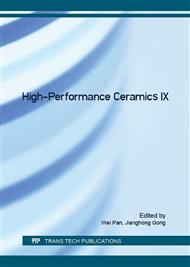p.275
p.279
p.284
p.288
p.293
p.297
p.303
p.307
p.311
Preparation and Mechanical Properties of BiFeO3 Ceramics
Abstract:
Hydrothermal method and sol-gel process were used to synthesize multiferroic BiFeO3 ceramics. X-ray diffraction, scanning electron microscopy, vickers diamond indenter and three-point bending method were used to investigate the effects of methods on the phase structure, microstructures and mechanical properties. Cold isostatic pressing on the ceramics with two different loads (10 MPa, 200 MPa) was used to illustrate the influence of pressure in mechanical properties. The results show that all samples are crystallized in the perovskite phase. A few small traces of impurity are observed at a 2θ of ~28 o, which are found to be those of Bi2Fe4O9. The SEM images depict that samples prepared by sol-gel process are more uniform and the grain size is slightly larger than that of hydrothermal processed samples. The investigations on the hardness and flexural strength demonstrate the ceramics prepared by hydrothermal method have better mechanical properties than that of sol-gel process, and the mechanical properties can be obviously enhanced by increasing pressure.
Info:
Periodical:
Pages:
293-296
Citation:
Online since:
July 2016
Authors:
Price:
Сopyright:
© 2016 Trans Tech Publications Ltd. All Rights Reserved
Share:
Citation:


